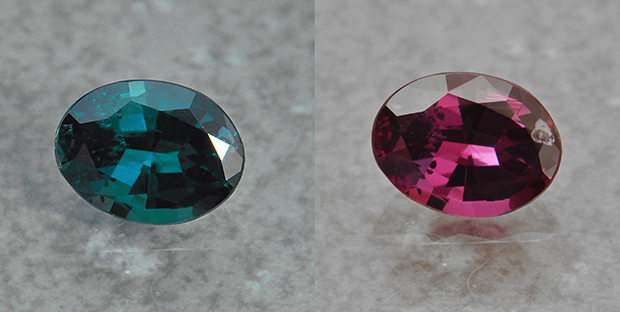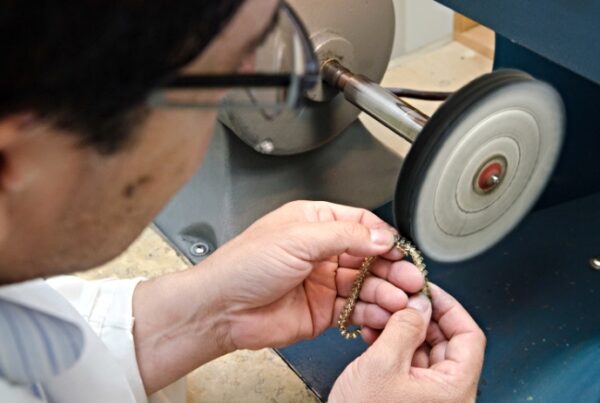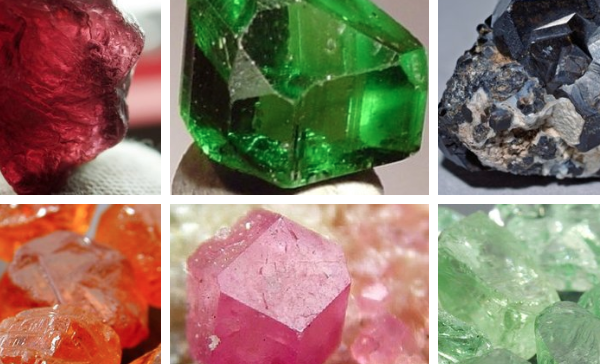“Emerald by day, ruby by night” – the stunning alexandrite gem is considered one of the most exceptional color-changing gems in the world. Alexandrite appears a brilliant emerald green in sunlight and a rich, raspberry red in incandescent light. This variety of chrysoberyl is considered to be one of the world’s most valuable and rare gems. It is so rare and expensive that very few people have ever seen a natural alexandrite. This exceptional gem is one of the birthstones for the month of June (shared with the pearl), as well as the 55th Wedding Anniversary gem.
The stunning color change phenomenon seen in alexandrite is referred to as the “alexandrite effect.” In daylight, alexandrite exhibits a brilliant emerald-green color. Under incandescent lighting, alexandrite becomes a deep red color. The finest quality stones make this color transition as smoothly as a traffic light changing colors. Alexandrite is also a pleochroic gem. It can display emerald green, red, orange and yellow colors depending on which angle the stone is viewed from.
Alexandrite was discovered in the Ural region of Russia in 1834. Who actually first discovered alexandrite is in question. One story is that it was discovered by the Finnish mineralogist Nils Gustaf Nordenskjold (1792 -1866). It is believed that while working with the gem through the light of day to candlelight at night, Nordenskjold discovered the gem’s unique color changing ability. He named it diaphanite.
Others attribute its discovery to Count Lev Alekseevich Perovskii (1792-1856), an important nobleman, Russian politician, and avid mineralogist. It is even possible that Perovskii, perplexed by the gem’s structural qualities, sent a sample to Nordenskjold to examine. Though it is doubtful that either man was the first to handle the mineral, they were probably the first persons to examine the gem under microscopes.
As for the name of alexandrite, in a shrewd political move, Count Perovskii chose April 17, 1834, the 16th birthday of future Czar Alexander Nikolaevich II, to publicly announce that the new gem would be called alexandrite in his honor. In time, the captivating green-to-red color change stone would become one of the most prized gemstones amongst Russian Aristocracy.
For about 150 years, Russia enjoyed exclusive access to this new, rare gemstone. Eventually, those in noble and royal positions in Europe and America managed to acquire alexandrite jewels made by some of the world’s most prestigious jewelers, such as Russia’s court jeweler Carl Faberge and designers from Tiffany & Co. Tiffany’s chief procurer of extraordinary gemstones, Dr. George Frederick Kunz, was so enamored of alexandrite that he traveled across Russia to buy up quantities of the gem. Tiffany ended up with reserves so large, that it cornered the market on the alexandrite for decades. Russian alexandrite remains the most desirable on the market, though most of it is housed in museums or private collections.
By the late 1890s, Russian mines were almost depleted of gem deposits. It was not until 1987 that a new source of alexandrite was discovered in Minas Gerais, Brazil. The South American deposits were found to be superior in color saturation than those previously found in Russia. After being heavily mined in the late 1980s, production from the Brazilian mines has dwindled significantly.
Today dealers seeking gem-quality stones turn to Sri Lanka. Although the color of these deposits does not compare with the stunning gems which were found in Russia and South America, they are still highly prized. Other recent deposits of lessor quality have been found in Myanmar (Burma), Tanzania, India (Andhra Pradesh) and Madagascar. The largest carat weight gems have been found exclusively in Russian and South America.
The vast majority of alexandrite gems available today are under one carat. In sizes up to one carat, top-quality natural gems sell for around $15,000. Over one carat, the prices range from $50,000 to $70,000 per carat. Stones of Russian origin have been commonly valued as high as $100,000 per carat.
Most large alexandrite gemstones can only be found in old period jewelry, since new material is so extremely rare and found only in small carat weights. Many English Victorian jewelry designs feature alexandrite stones, but mostly smaller stones. Antique Russian jewelry designs are famous for the size of the gemstones in their settings. The largest alexandrite gems have been found exclusively in Russia and South America.
In Russian legend, alexandrite crystal powders were thought to carry good luck, fortune and love to its owner. It has been associated with discipline and self-control. Alexandrite has also been said to promote concentration and strengthen the ability to learn. Alexandrite has been believed to be the stone that could bridge the physical and spiritual world.
Alexandrite gemstones are typically untreated, but imitation stones do exist. It is very expensive to create synthetic alexandrite, so even lab-grown stones can be very costly. Synthetic alexandrite has been available on the market since the 1960s.




